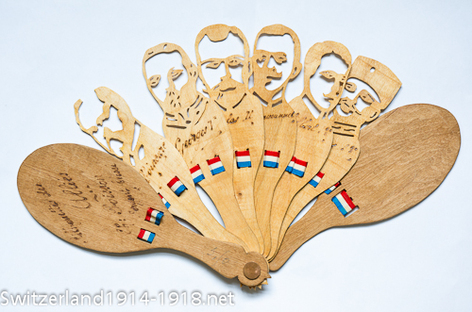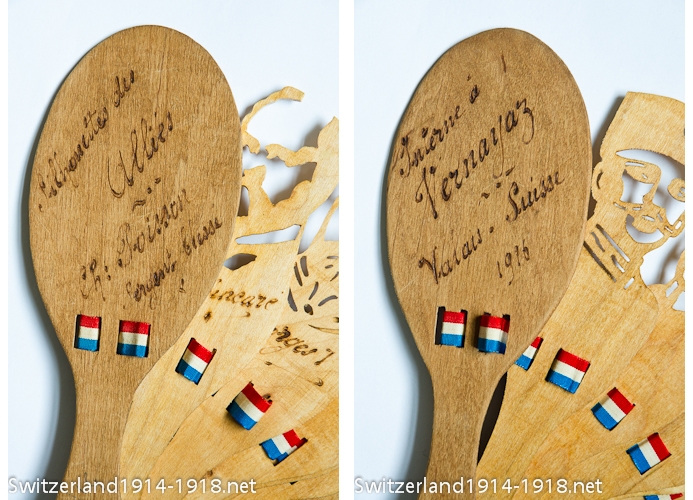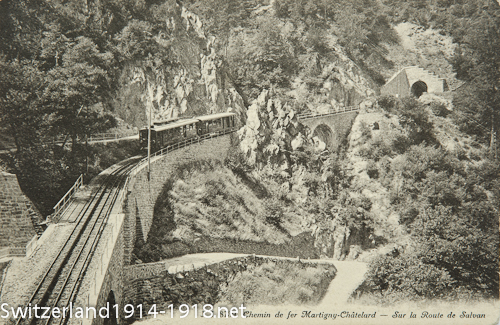I obtained this unusual 'fan' from a seller in the USA, who had bought it at an estate sale in the San Francisco Bay area. Inscriptions on the item indicate that it was made in 1916 by a French soldier who was interned at Vernayaz (a town in Switzerland). Apart from that, nothing else was known about it, but I have managed to discover some of the fascinating story behind this curious object.

The 'fan' consists of hand-carved silhouettes of the heads of state of the six main Allied countries in 1916: French President Raymond Poincaré, King George V of Britain, the Russian Tsar Nicholas II, King Victor Emmanuel III of Italy, King Albert I of Belgium and King Peter of Serbia. At either end there is a rounded piece of wood that protects the fragile carvings. The clever feature of this item is that when held up to a strong light source, it casts detailed shadows of each of these men.

The first stage in researching this artefact was to examine the clues written on it. At one end was "Silhouettes des Allies. Ch: Poisson. Sergent blessé", and at the other end "Internée à Vernayaz. Valais. Suisse. 1916". The first three words refers to the carved wooden silhouettes of the Allied leaders. The remainder indicates that it was made in 1916 by a Sergent (Sergeant) Poisson, whose Christian name was abbreviated to "Ch", who had been wounded and was interned at Vernayaz, in the Valais canton of Switzerland. It does not explicitly say that he made it, but this seems a logical assumption. These details provided a good starting point...
Above: French internees in Switzerland doing agricultural work. Internees were expected to work if they were well enough.
ICRC records
The first stop in my research was the First World War prisoner of war archives of the International Committee of the Red Cross (ICRC). As I have described before, these records are not always straightforward to use but can contain detailed information. There were at least eight men called "Ch Poisson" in the ICRC's on-line records (one man can appear on multiple cards, and it may not be immediately obvious if each reference is to the same or a new individual). Further searching in the ICRC records revealed the following details about the man who carved this souvenir of his time in Switzerland:
The first stop in my research was the First World War prisoner of war archives of the International Committee of the Red Cross (ICRC). As I have described before, these records are not always straightforward to use but can contain detailed information. There were at least eight men called "Ch Poisson" in the ICRC's on-line records (one man can appear on multiple cards, and it may not be immediately obvious if each reference is to the same or a new individual). Further searching in the ICRC records revealed the following details about the man who carved this souvenir of his time in Switzerland:
- Charles Francisque Poisson was born in Paris on 11 May 1886, so he was aged 28 in 1914.
- He was a sergeant (sergent, in French) in 15th Company, 43rd Colonial Infantry Regiment (43e Régiment d'Infanterie Coloniale) of the French army.
- After being taken prisoner by German forces, he arrived at the 'Reserve-Lazarett' (hospital) at Bayreuth, Bavaria, on 21 August 1914, and left there on the 30th.
- He was seriously wounded, and is later described as having a “stiff leg”, presumably meaning that he was left with a permanent disability as a result of his wound.
- He was held by the Germans as a prisoner of war in at “Gef. Btl II St Georgen Bayreuth”, presumably meaning Prisoner of War Battalion No.2, located in the St Georgen district of Bayreuth, Germany.
- In August-September 1915 the ICRC corresponded with his family, presumably to confirm that he was a PoW.
- By early June 1916 he had moved to Vernayaz as an internee (note that the first French prisoners of war arrived in Switzerland for internment in January 1916). His accommodation was at the Grand Hotel des Gorges du Trient, and he was one of 60 French internees kept there.
- On 26 September 1918 he was one of a group of French soldiers repatriated to France.
So the ICRC's records gave a pretty detailed outline of Sergent Poisson's time as a prisoner of war (PoW) and then an internee in Switzerland. This could be fleshed out from other sources, as follows.
Above: illustration of the silhouettes cast by this artefact.
Events in 1914: The Battle of Morhange
What of Sergent Poisson's early history, before he became a prisoner of war? I have not found anything about his individual experiences, but the history of the French 43rd Colonial Infantry Regiment gives some clues (Source: tableaudhonneur.free.fr). The regiment did not exist before the First World War. It was formed on 2 August 1914 from reservists from Paris and the surrounding area, with some of the officers and NCOs having served in the colonial army (it is unknown whether these included Sergent Poisson). It began to assemble at the school in rue Huyghens, Paris (the building can still be seen on Google Streetview).
What of Sergent Poisson's early history, before he became a prisoner of war? I have not found anything about his individual experiences, but the history of the French 43rd Colonial Infantry Regiment gives some clues (Source: tableaudhonneur.free.fr). The regiment did not exist before the First World War. It was formed on 2 August 1914 from reservists from Paris and the surrounding area, with some of the officers and NCOs having served in the colonial army (it is unknown whether these included Sergent Poisson). It began to assemble at the school in rue Huyghens, Paris (the building can still be seen on Google Streetview).
On 7 August the regiment left Paris by train for the French border with Germany in the Lorraine region. The regiment was part of the “brigade coloniale” (Colonial Brigade) along with the 41st Colonial Infantry Regiment, and was attached to the 20th Army Corps.
In 1871 the former French regions of Alsace and Lorraine had been seized in the Franco-Prussian war and incorporated into Germany. In 1914, a key part of the French strategy was to advance into Alsace-Lorraine, both to try to recover these lost territories and to unbalance the German offensive. The 43rd Colonial Infantry Regiment was a small part of the French First and Second Armies that took part in this attack, which became known as the Battle of Lorraine (14-25 August 1914), of which the Battle of Morhange (14-20 August) was the action in which the regiment was involved. This was a period of mobile warfare, before the opposing forces began digging the extensive trench systems that dominated so much of the war on the Western Front.
On 19 August 1914 the 43rd Colonial Infantry Regiment crossed the German border and occupied the villages of Oron and Chicourt, from which the Germans had departed only hours earlier. The next day was the first time that the regiment saw action. After suffering a heavy German artillery bombardment and then overwhelming attacks by Bavarian infantry, the regiment (and other nearby French troops) had to fall back; its commander was seriously wounded and many men had become casualties.
After the French advances of the preceding days, on the final day of the Battle of Morhange (20 August) the Germans counter-attacked, leading to a German victory and thousands of French casualties. Today there is a memorial at Oron to 77 soldiers of the 43rd Colonial and 146th Infantry Regiments who died there. (Source: pierreswesternfront.punt.nl). There is a moving account of the battle (in French) here: www.blamont.info.
It seems most likely that Sergent Charles Poisson was wounded and became a prisoner of the German army on this occasion. However it is strange that the ICRC records apparently show him in hospital in Bayreuth (some 400km away) on the next day. It is possible that the date in the ICRC records of 21 August 1914 refers to him being taken prisoner rather than arriving at the hospital? The other possibility is that Sergent Poisson was taken prisoner before 20 August, although his regiment does not seem to have been close enough to the enemy before that date for that to have been possible.
After the French advances of the preceding days, on the final day of the Battle of Morhange (20 August) the Germans counter-attacked, leading to a German victory and thousands of French casualties. Today there is a memorial at Oron to 77 soldiers of the 43rd Colonial and 146th Infantry Regiments who died there. (Source: pierreswesternfront.punt.nl). There is a moving account of the battle (in French) here: www.blamont.info.
It seems most likely that Sergent Charles Poisson was wounded and became a prisoner of the German army on this occasion. However it is strange that the ICRC records apparently show him in hospital in Bayreuth (some 400km away) on the next day. It is possible that the date in the ICRC records of 21 August 1914 refers to him being taken prisoner rather than arriving at the hospital? The other possibility is that Sergent Poisson was taken prisoner before 20 August, although his regiment does not seem to have been close enough to the enemy before that date for that to have been possible.
Time as a prisoner of war and internment in Switzerland
So Sergent Poisson became a prisoner of war only weeks after the conflict began, and remained in confinement (as a PoW then an internee) for just over four years. Read more about the overall process of interning PoWs in Switzerland on this website here. The men chosen for internment in neutral countries were generally those prisoners who had severe and long-lasting injuries or illness, and/or who had been a prisoner for a long period (the latter point reflected the psychological toll on the individual of long periods of incarceration).
So Sergent Poisson became a prisoner of war only weeks after the conflict began, and remained in confinement (as a PoW then an internee) for just over four years. Read more about the overall process of interning PoWs in Switzerland on this website here. The men chosen for internment in neutral countries were generally those prisoners who had severe and long-lasting injuries or illness, and/or who had been a prisoner for a long period (the latter point reflected the psychological toll on the individual of long periods of incarceration).

Above: a postcard showing the Martigny-Châtelard railway, not far from Vernayaz, which was sent in 1916 by another French prisoner of war, who was interned at Finhaut.
Interned at Vernayaz
The town of Vernayaz (map) sits in a mountain valley and is in fact only about 13km from the French border. The building that was the Grand Hotel des Gorges du Trient at Vernayaz still exists, though it is now used as offices and is no longer a hotel. Built in 1870, it was the most impressive of a number of hotels built in the town around this time to take advantage of tourists visiting the area to walk in the mountains, prompted by the extension of the railway to the valley. The most prominent local attraction was the 200 metre deep Gorges du Trient (Trient Gorge), which is fed by the Trient Glacier higher up in the mountains. The hotel had space for 80 people in its 50 rooms. (Source: www.vernayaz.ch) By 24 June 1918 there were in fact 80 internees in this building, so it was full! (Source: hopitauxmilitairesguerre1418.overblog.com). Other records on the ICRC website show that there were a further 186 interned former prisoners of war close by at Salvan (just to west of Vernayaz, at a higher altitude), and more at Finhaut (to the south west) and Martigny (to the south east).
The town of Vernayaz (map) sits in a mountain valley and is in fact only about 13km from the French border. The building that was the Grand Hotel des Gorges du Trient at Vernayaz still exists, though it is now used as offices and is no longer a hotel. Built in 1870, it was the most impressive of a number of hotels built in the town around this time to take advantage of tourists visiting the area to walk in the mountains, prompted by the extension of the railway to the valley. The most prominent local attraction was the 200 metre deep Gorges du Trient (Trient Gorge), which is fed by the Trient Glacier higher up in the mountains. The hotel had space for 80 people in its 50 rooms. (Source: www.vernayaz.ch) By 24 June 1918 there were in fact 80 internees in this building, so it was full! (Source: hopitauxmilitairesguerre1418.overblog.com). Other records on the ICRC website show that there were a further 186 interned former prisoners of war close by at Salvan (just to west of Vernayaz, at a higher altitude), and more at Finhaut (to the south west) and Martigny (to the south east).
Above: A photograph of interned French soldiers infront of the building in which Sergent Poisson was interned - he may even be one of the men pictured here! Source: booklet "Les internés en Suisse: Les Alliés" (Editions Atar, 1917).
To sum up: starting from a few details written on a First World War artefact, it has been possible to uncover a whole story. If anyone has comments on this or useful additional information, I would be pleased to hear.



 RSS Feed
RSS Feed
